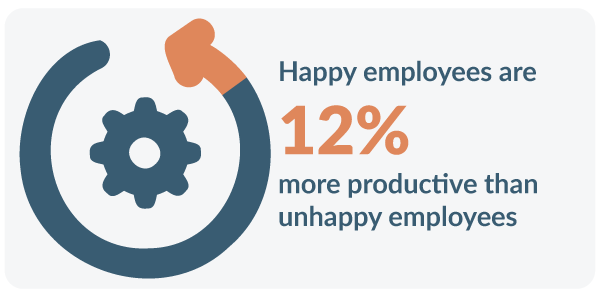45 Sample Questions for Employee Satisfaction Surveys

Are your employees happy and content with their jobs? If you can’t say with the utmost certainty that most of your employees are happy and content, it’s time to do an employee satisfaction survey and find out.
An employee satisfaction survey allows HR pros to measure employees’ feelings of contentment and empowerment regarding various components of their job. It’s accessed via an internal online link, allows anonymity and gives HR pros direct employee feedback on a number of specific topics. These can be inclusion and belonging, compensation, general benefits and wellness, health benefits, supervisor performance, career development, work environment, DE&I, team performance, and the list goes on.
Its purpose is to provide actionable data that’ll help organizations improve their employee experience by boosting engagement and productivity. Why is this important?

Because happy employees are 12% more productive than unhappy employees, according to a study by the University of Warwick in Coventry, England. But boosting productivity isn’t the only reason to do employee satisfaction surveys. Organizations that don’t do them can suffer from high turnover, low morale and a decreased ability to recruit top talent.
Employee satisfaction survey questions
Here’s a list of 45 questions you can ask, broken up into categories.

Company culture
- Do you enjoy our company’s culture?
- Do you feel connected to your co-workers?
- Do you enjoy working with your colleagues?
- Do you feel your colleagues work as a team?
- Do you feel valued by the company for your contributions?
- Are you satisfied working for the company?
- Do you feel the company is open to change?
- How well does the company communicate news and important information?
- When problems arise, how well does the company handle them?
- Would you describe all staff meetings as essential?

Job satisfaction
- How happy are you at work?
- Do you feel your work is meaningful and valued?
- Do you think you’re given enough freedom to decide how to do your work?
- Do you know what is needed to meet your goals and objectives?
- Do you have the materials and equipment you need to do your job well?
- Do you find your workload reasonable?
- Do you think that work is distributed evenly across your team?
- How well would you say the job description matches your current roles?
- Are your daily tasks closely related to your professional skills?
- Would you recommend our company to friends and family?
- Would you apply for your job again if you had to do it all over?
- Do you feel like all of your talents are being used in your position?
- Does your job cause you stress?

Professional growth
- Do you feel that you are growing professionally?
- Do you get the learning and development opportunities that you want?
- Do you have room to grow within the company?
- Do you feel that your job allows you to develop new skills?
- Do you feel like your job utilizes your skills as much as it could?
- Do you feel the company offers adequate opportunities for promotions and career development?
- Do you see a path at the company to advance your career?

Manager relationship
- Does your manager ask for feedback and value when it’s offered?
- Does your direct manager value your opinions?
- Do you feel like your roles and efforts are appreciated by your supervisors?
- Does management seem invested in the team’s success?
- Do you feel management is transparent?

Compensation and benefits
- Do you feel your benefits package is competitive?
- Does the company provide enough benefits when it comes to your well-being and mental health?
- Is your pay rate enough to keep you from taking a second job?
- How likely are you to get leave time when you need it?
- How much would you like to change about your current benefits package?

Work-life balance
- What is your stress level on a typical workday?
- Do you feel like you have been offered the support and flexibility necessary to thrive at work?
- Do you have to work at night and on the weekend to get your job done?
- Does the company provide you with enough PTO?
- Have you ever canceled plans of a personal nature to handle your workload?
These questions are a jumping-off point. You can always ask more or just a portion of them, depending on the topic you’re interested in knowing more about.
Importance of employee satisfaction surveys
Finding out how your employees really feel and understanding why they feel that way will help HR identify areas that need improvement. Employee satisfaction surveys offer valuable insight into what employees want and need when it comes to enhancing the employee experience, boosting employee engagement and increasing productivity throughout the organization.
They’re simple and effective, and provide a lot of data HR pros can use to improve the employee experience and productivity.
Some of the benefits of these surveys include:
- Providing real-time insights – Employee satisfaction surveys tell you how employees truly feel – not how management thinks they feel – now. HR can report the findings to the executive team, and they can act upon the findings in a short time, making decisions and planning interventions that will bring about effective results.
- Showing employees the organization cares about them – When companies do periodic employee satisfaction surveys, it opens a two-way communication line with their people. It also shows employees the organization cares about them, making them feel heard. This builds trust and transparency which is vital for growth and change, and boosts employee engagement.
- Highlighting areas that need help. Allowing employees to give anonymous feedback means management is hearing honest feedback. This provides the organization with a chance to identify areas that need improvement and come up with employee-guided solutions that work. When people see that management is listening to them, it makes them feel valued and happy, increasing their motivation to work harder and better.
- Reducing trial-and-error fixes. Periodic, targeted employee satisfaction surveys allow organizations to target fixes, reducing the need for crafting multiple solutions. They can get to the fix faster which saves time and money. And when employees see they were part of the solution, they feel ownership in the business.
- Increasing productivity. Feeling a part of the company means employees are more engaged and, therefore, more productive. They want the company to succeed.
- Reducing turnover. “Employees are 87% less likely to quit a job if they are engaged in the workplace,” according to a recent study by Wellable. Providing employees with a culture where they feel listened to, valued and engaged means organizations will retain their employees, their knowledge and their investment in them.
- Creating happier places to work. Getting continuous feedback from employees helps organizations provide employees with great experiences. That translates to happier places to work where employees can thrive.
Employee satisfaction and employee engagement aren’t interchangeable
One important factor to note is employee satisfaction surveys and employee engagement surveys are two different measurements. They both aid in making organizations better places to work, but they’re not the same thing.
Employee satisfaction surveys are “direct feedback tools that let employees share their opinions and experiences,” according to Indeed. They measure the contentment of an organization’s employees and identify areas that need improvement. Employee “satisfaction is tied to elements such as compensation, benefits, recognition, work-life balance, workload, company culture, effective leadership, etc. Ensuring [an organization] meets both the material and intangible needs for employee satisfaction is critical for retaining top talent and improving engagement in [an] organization,” details SurveyMonkey.
Employee engagement surveys are “designed to measure and assess how motivated and engaged [an organization’s] employees are to perform their best at work each day,” according to PeoplePulse. They provide insight into how employees feel about their work and the overall environment.
Developing employee satisfaction surveys
There are no one-size-fits-all instructions for creating effective employee satisfaction surveys. The development of a survey depends on the organization and what they want to garner from the results of the survey.
But here are some general steps employers can use to customize their survey:
- Select survey parameters: First and foremost, HR pros need to know what their company wants to measure before they can create survey questions. Basic topics to survey can include things like the actual job, the employee’s direct supervisors, peers, professional development, benefits, compensation, company leadership, etc. From there, HR pros can delve deeper into these topics with additional questions on specific aspects.
- Write questions: Keep survey questions short, friendly and easy to understand. Don’t use jargon. Make the questions conversational, but direct – don’t add extra information. Only ask a question once. Even if it can be asked in a different way using different words, don’t. Only ask one question at a time. And use a mix of question types – open-ended, multiple choice, rating scale, ranking, etc. – to get the best results.
- Keep surveys short: Now there is an exception to this step. The first employee satisfaction survey conducted will be on the longer side because it’ll be used as the base survey that you can compare future surveys. This survey should be comprehensive and include up to 30 questions, advises SurveyMonkey. Warn employees the first survey is long and that their full participation is wanted and appreciated. After that, try to keep follow-up surveys to 10 questions to avoid too much data and survey fatigue from employees.
- Test out the survey: Have executives and supervisors do a survey test run. The last thing HR pros want to happen is a technical glitch or users encountering confusing questions.
Running your survey
Surveys aren’t something you can sit down and whip out in an hour after lunch. They take meeting with key people in the organization to figure out what you’re going to test and why. Then there is the crafting of the survey, getting feedback on the survey from the key people and implementation of the feedback.
After all the time and effort HR pros put into developing their employee satisfaction surveys, they want to make sure they’re effective and successful in gathering the desired data. To do that:
- Emphasize surveys are anonymous: It’s important to let employees know with every survey that their responses are anonymous, otherwise, some people may not participate. And you want each and every employee to participate to get a true gauge of how the entire workforce is feeling.
- Be transparent: Let employees know at the beginning of every survey what’s being measured and why. It encourages participation. And let them know approximately when you’ll be sharing the results of the survey with them.
- Offer incentives: Unfortunately, cash is king when it comes to encouraging the most responses, according to SurveyMonkey. Monetary incentives can include anything from cash to gift cards to coupons. Nonmonetary incentives typically include thank-you gifts like company swag. If there isn’t a budget for a little monetary incentive, make sure the nonmonetary incentive has “universal appeal” to the target audience.
- Remind employees of the deadline: Two weeks is a good time frame to give employees for taking an online survey. This way people who have paid time off can participate when they return. What’s vital about the deadline is sending a reminder a few days before it. People get busy and forget. A friendly reminder can get the stragglers to submit their surveys.
There are numerous tools available that HR pros can use to create and run their surveys. To figure out which software solution is best for your purposes, Connecteam suggests asking:
- Is it easy for HR pros and employees to use?
- Can you customize it?
- Does it offer multiple types of questions?
- Are templates offered that you could build off?
- Can you send surveys and receive feedback in real-time?
- Does it offer performance metrics?
- Is it cost-friendly?
- How is its customer support?
Evaluating survey results
Now that all the survey results are in, it’s time to do something with the data collected.
What’s the best way to go about analyzing the survey results?
- Quantify the data. Numeric scores are easier for most people to understand, compare and identify patterns/trends. So whenever possible, work with concrete numbers.
- Break data down into groups. Whether it’s by departments, demographics or whatever, segmenting data will provide a deeper insight.
- Find patterns and trends. For example, let’s say most employees are happy with your health benefits. But when you take a deeper dive into the category you notice it’s the younger employees who are happy with them, your older employees aren’t. You can delve even deeper into the category by looking at something like older employees’ salaries to see if there’s a pattern there with being unhappy with health benefits.
- Determine if the results are statistically significant. You want to know if your results have a certain level of accuracy. Take, for example, getting 500 finished surveys from a possible 1,000 employees. And you find 80% of your workforce is satisfied with compensation. Not bad, right? Wrong. After further analysis, you see 90% of the respondents were male when 50% of your workforce is female. Therefore, it’s an inaccurate representation of the company’s total population and isn’t statistically significant.
- Compare the results to your benchmark survey. Remember earlier when we said the first survey would be longer? That’s because you’ll compare future employee satisfaction survey results to it. For example, say your initial survey found junior employees didn’t feel listened to. You implemented new strategies to change that. In a follow-up survey, junior employees say they feel like they’re being listened to. Now, you know the strategies you implemented worked.
Acting on survey results
Once survey data is analyzed, it’s time for HR and leadership to do something with the results.
Here are steps you can use to maximize the benefits of employee satisfaction surveys:
- Thank employees: After the deadline has passed, send a thank-you email to employees for taking the time out of their day to fill out the survey. Include a brief explanation of why it was so important, when you expect to have the results ready and what you plan to do with the information.
- Meet with management: Once the data is compiled, gather supervisors and managers together and review the results. Discuss what the results mean to their department and what actions they think should be taken for their team and the company as a whole to increase employee satisfaction. Managers must understand what the data says and how it affects their team dynamics before the results can be presented to everyone.
- Create a concrete action plan: Now it’s time to prioritize the results and create an action plan to achieve the goals. Note: It may not be realistic to tackle everything the survey uncovered. Think about prioritizing goals according to which will have the greatest impact.
- Discuss results with the workforce: After leadership, management and HR have scoured the results together, identified areas that need improvement and come up with an action plan, it’s time to share the results with the entire workforce. Provide the narrative of the results: the what, when, where and why. It’s more impactful than just spitting out a litany of data. Plus, it allows employees to better understand the big picture.
- Follow up: After you have implemented your action plan, send out follow-up surveys to see if the plan achieved its goals. With every subsequent survey, HR can drill down even further into workplace issues.
When employees see their organization taking the time to send employee satisfaction surveys and then act on their responses, it makes them feel valued which in turn creates a happier and more productive workforce. And employees who are happy and satisfied are more likely to stay, decreasing turnover and onboarding costs.
So, while it may cost some time and money to do regular satisfaction surveys, they more than pay for themselves when it comes to productivity and retention.









